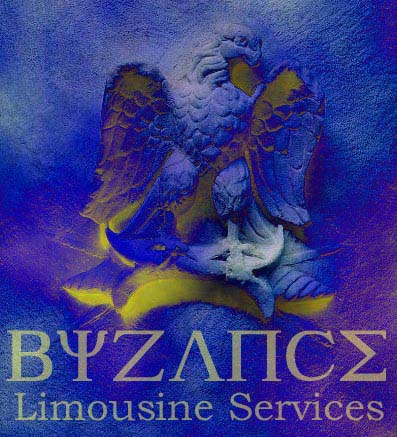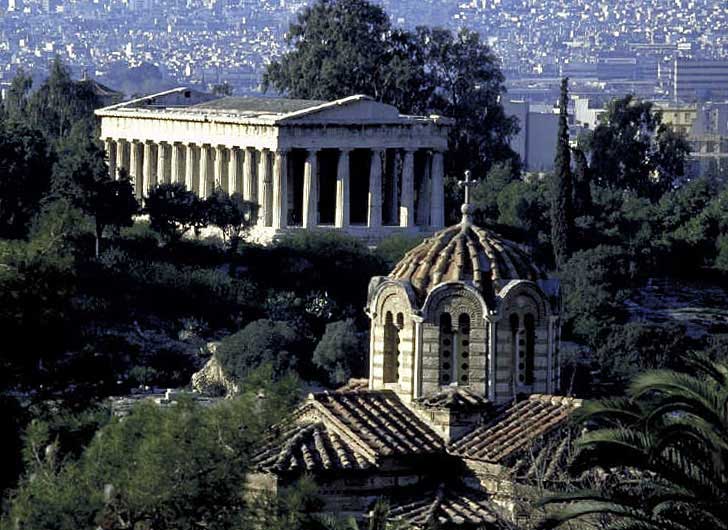|
Ephesus,
Turkey
Kusadasi,
Turkey
Izmir,
Turkey
Istanbul,
Turkey
Athens,
Greece
Santorini,
Greece
Rates
Our
Fleet
F
A Q
E-Mail



|
Athens,
Greece
Athens
is the capital of Greece. It became capital during the reign of
King Otto in 1834. Back then it was a small town with only 10.000
citizens. Today, the population of Athens including its suburban
areas reaches the number of 4.000.000. Athens is characterized by
Greek poet Kostis Palamas in one of his poems as 'the sapphire
stone of the worlds ring'. According to mythology the name
'Athens' was given to the city by goddess Athena and that is why
ancient Athenians worshiped her. Athena gave them as a first gift
the olive tree which is the symbol of peace. During the time of
Pericles the Athenians built the Parthenon to honor the goddess
Athena. Millions of tourists visit Athens every year to view this
magnificent specimen of human craftsmanship.
THE ACROPOLIS
The word 'Acropolis' is the union of two
Greek words: Acro + Poli. 'Acro' means the outer most point and
'Poli' means city. The Acropolis of Athens is the most significant
citadel of Greece. It lies upon a rock whose height reaches 156
meters (512 feet) above sea level. There is a precipice on three
sides and only the west side is accessible. The history of the
Acropolis of Athens goes way back. Remains from the very early
Neolithic era were found on top and the sides of the rock. During
the Mycenic period (1600-1100 B.C.) the Acropolis was fortified
with 'Pelasgian walls'. These walls were made out of enormous
6-meter (20 feet) wide slabs ( at that time the Acropolis was the
center of the city and the kings base). Around the palace were the
houses of noblemen. When enemies were present every citizen would
flee there for protection. As the years passed by the city grew
and its form changed (the king is no longer situated on top of the
Acropolis). During this time the Acropolis is turned into a
spiritual center (named Sacred Rock) with sacred temples
surrounding it. We reach the Historical period where we find newly
built sanctuaries and the foundations of the temple of 'Athena
Poliad' (built around 570 B.C.) beneath the Caraytids statues. The
sculptures of this temple can be found today in the museum of the
Acropolis. Archaeologists state that there were more buildings,
temples and statues during that period on the Acropolis. All of
them though were destroyed by Persian hordes around 480 B.C. The
contemporary form of the 'Sacred Rock' began after the Persian
Wars around 450- 420 B.C. when Pericles was lord of Athens.
Pericles assigned a great task to three top artists of that time
(Phidias, Iktinos and Kallikratis). The task was to rebuild
anything that had been destroyed by the Persians and to decorate
the Sacred Rock once again. Phidias was the general supervisor and
Iktinos with Kallikratis were the architects. This was the time of
the 'Propilea' (entrance of the Acropolis), the temple of Athena
Nike, the Erechtheion with its famous Caraytids and last the
Parthenon which is considered to be one of the most beautiful
buildings of all time. The Parthenon was built in honor of 'Athena
Parthenos' who saved the city of Athens from the Persians. It was
built with Pentelic marble and was of Doric style. The exterior
was decorated with many sculptures which were all creations of
Phidias and of his pupils. Inside the temple stood the
golden-ivory statue of the goddess Athena that held in her right
hand goddess Nike. Outside the temple and towards the 'Propilea'
stood the bronze statue of 'Athena Promachos' which was also a
creation of Phidias. Pericles did not succeed to see the
completion of everything that he had visioned. He only saw the
Parthenon and the 'Propilea' everything else was completed after
his death. Up until the Roman Empire everyone respected the
Acropolis. When Christianity prevailed as a religion, the
Parthenon became a church called 'Madonna the Athenian'. The same
thing happened to the Erechtheion. During the rule of the Franks
the Parthenon became a Catholic church and during the Ottoman
conquest of Greece it was transformed into a mosque. During that
time the Turks used the temples as a storage facility for
gunpowder. During the Venetian siege in 1656 and 1687 a great part
of the Acropolis was destroyed from explosions. The Acropolis was
released from Turkish siege and returned to the Greeks in 1833.
Since then excavations and preservation of the site have been
taking place.
KALIMARMARO
STADIUM
The Kallimarmaro stadium occupies the
exact site of the original Panathenaic Stadium which was built in
330 BC. It is built with white Pentelic marble, it is 204 meters
(669 feet) long and 83 meters (272 feet) wide and has a capacity
of 60,000. It was first reconstructed during Hadrian's reign
(76-138 AD) and then rebuilt in white marble by Herodes Atticus
for the Panathenaic Games in 144 AD. The site was excavated
between 1869 and 1879 by Ernst Ziller. In 1895 George Averof gave
4 million drachmas in gold (about $15,000) in order to restore the
stadium in time for the first modern Olympic Games on April 5th,
1896. The stadium's contemporary structure is a true copy of the
one built in 144 AD by Herodes Atticus.
LYCABETTUS HILL

Lycabettus Hill is really a limestone
rock located in the center of Athens. In ancient Athens it was
located outside of the city's walls. It has a conical shape and
its height reaches 277 meters (908 feet). The name Lycabettus has
something to do with the first light of the day or with the
astrological observations of the ancient Athenians. On the west
side of the hill there used to be a tank from where Athenians were
supplied with water. Today on top of the hill you will find a
small whitewashed chapel of St. George which was built in the 19th
century. Also on Lycabettus hill you will find a restaurant, cafes
and the Theatre of Lycabettus where various artists from around
the world perform (pop, rock, jazz and dance).
PHILLOPAPUS
HILL
The Philopappus hill is the highest
summit in the south of Athens. Its height reaches 147 meters (482
feet) and from up there you get a magnificent view of the
Acropolis. The name Philopappus comes from a monument still which
was built around 115 A.D. in honor of the Roman consul 'Caius
Julius Antiochus Philopappus'.
THE PRESIDENTIAL
PALACE
The Presidential Palace was built in 1878
by Ernst Ziller. It was occupied from 1890 until 1973 by the Greek
Royal Family. It has been the seat of the Greek Parliament since
1935 and following the abolition of the monarchy it became
official residency of the Prime Minister of Greece.
CAPE SOUNION

During antiquity Sounion was an important
municipality of Attica that included a fortress within its cape
(for the ship-navigation control), as well as two important
sanctuaries of Poseidon and Athena Sounias. The fortified top of
the cape was one of the five important fortresses that was
responsible for the protection of the Attica region. Fortification
is likely to have existed from the old times, not only because
Sounion was an advanced military naval station for the Athenians,
but also because of its position (the harbor sheltered each boat
that was in danger). It is expressly reported that there was a
fortification in the winter of 413-412 B.C. (the Athenians wanted
to make sure that their ships which carried wheat would be
protected). It was then when probably some rich tradesmen or
seamen dedicated to the sanctuary about 10-12 oversized marble
kourous. These statues certainly created a great impression to
all the seamen that would pass by with their ships. Some of the
kourous that were found are exposed today in the National
Archaeological Museum of Athens. The temple that the Athenians had
begun building after 500 B.C., suffered great damage during a
Persian raid. Around the mid-5th century B.C. with the inspiration
of Pericles, the Athenians started building the classic temple of
Poseidon. It was a temple of Doric style with 6x13 columns with a
double internal colonnade (where the statue was situated).
THE PLAKA
This is Athens oldest and most
picturesque neighborhoods located on the north and northeast side
of the Acropolis. Plaka is known to the locals as 'the
neighborhoods of the gods'. The name 'Plaka' is apparently derived
from a very large white plaque that was located at the junction of
Thespidos, Adrianou and Tripodon Streets. Plaka was a
well-maintained and fortified area during antiquity, while the
ancient Athenians based their agora (marketplace and town commons)
in the same general vicinity around the 8th century BC, a model of
urban planning followed by other ancient Greek city-states. The
distinctive architecture of Plaka as well as the large number of
monuments located in the district, dating from various historical
periods (Classical, Roman, Byzantine and Ottoman) gives an
overview of Athens' historical development. The monuments and
sites include: the ancient Agora of the Classical Era, Doric
Temple of Hephaestus and Athena, and the marketplace of Caesar and
Augustus, which is known as the Roman Forum. The Roman Forum had
two entrances - on the west side there was the imposing gate of
the goddess Athena, which still dominates the area and which today
is used as the entrance for horse and carriages, while on the east
side, there was an entrance for pedestrians. On the east side of
the Roman Forum, there is also a monument called the Tower of the
Winds. The remains of what used to be Hadrian's library, one of
the largest in the ancient world, can also be found in Plaka. The
Stoa of Attalos has also been preserved. Another well-known
monument found in Plaka is that of Lysicratus, located in
Lysicratus Square and built by Lysicratus himself, a patron of the
annual music contest held in the theatre of Dionysus. The churches
that can be found in the Plaka include the Metropolis of Athens,
the Sotiria of Lykodimus, the Anglican church of St. Paul's, St.
Catherine's, Sotira of Kottaki, St. Nicholas Ragava, St. John the
Theologian and St. Apostolos of Solaki, the Metamorphosis of the
Savior Church, the Madonna Gorgoepikoo or the small Metropolis and
the Metochi of the Panagiou Tafou (Church of the Holy Sepulchre).
There are also many cultural monuments found in Plaka as well due
to the pleasant and protected environment the district offers.
There are more than 10 museums currently located in the district,
including the Museum of Greek Popular Art, the oldest museum of
the area that includes collections of traditional handicrafts; the
Kanellopoulos Museum, with its exhibitions of artifacts dating
back from the Prehistoric Period right up until the end of the
19th century, and the Jewish Museum of Greece, with its exhibits
depicting the daily and religious life of the Jewish communities
of Greece. The museums in the Plaka are the Center of Popular Art
and Tradition, the Historical Museum of the University of Athens,
the Centre for the Study of Modern Ceramics, the Museum of Greek
Popular Musical Instruments (the Museum of Phoebus Anogianakis),
and the Greek Children's Museum. Plaka is also well-known for
taverns, coffee shops and clubs. Plaka is the birthplace of the
Athenian 'serenade' and it is also the location where many
Athenians celebrate the annual carnival.
NATIONAL
ARCHAEOLOGICAL MUSEUM
This museum first opened in 1891 and has
a priceless collection of unique exhibits such as sculpture,
pottery and jewelry. Unquestionably one of the world's best
museums.
|

